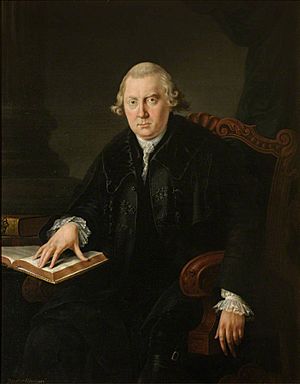John Gregory (moralist) facts for kids
Quick facts for kids
John Gregory
|
|
|---|---|

John Gregory
|
|
| Born | 3 June 1724 |
| Died | 9 February 1773 (aged 48) Edinburgh
|
| Education | University of Aberdeen University of Edinburgh |
| Occupation | Scottish physician, medical writer and moralist |
John Gregory (born June 3, 1724 – died February 9, 1773) was an important Scottish doctor, writer, and thinker. He lived during a time called the Scottish Enlightenment, which was a period of great learning and new ideas in Scotland.
Contents
Early Life and Education
John Gregory was born in Aberdeen, Scotland. His father, James Gregorie, was a professor of medicine. His grandfather was James Gregory, a very famous mathematician and astronomer.
When John was eight, his father passed away. His education was then guided by his grandfather and his older half-brother, James. His cousin, Thomas Reid, who was a philosopher, also helped him learn.
John went to a local grammar school. Later, he studied at King's College at the University of Aberdeen. In 1742, he moved to Edinburgh with his mother. There, he began to study medicine. He became good friends with a doctor and poet named Mark Akenside.
In 1745, John traveled to Leiden to continue his medical studies. He earned his degree in 1746. Soon after, he became a professor of philosophy at King's College. He taught subjects like mathematics and natural philosophy, which was an early form of science. He was also a practicing doctor. John preferred helping patients over giving lectures. So, he left his teaching job in 1749.
Family and Moving to London
On April 2, 1752, John Gregory married Elizabeth Forbes. They had three sons and two daughters. One of their sons, James Gregory, also became a well-known doctor. Their daughter, Dorothea Gregory, became a friend to Elizabeth Montagu. Elizabeth Montagu was a leading figure in a group of educated women called the "Bluestockings."
In 1754, John and his family moved to London. There, they joined a social group that included important people like John Wilkes and Elizabeth Montagu. Around this time, John started spelling his last name "Gregory" instead of "Gregorie." In 1756, he was chosen to be a member of the Royal Society. This was a very respected group for scientists. After a few years, Gregory moved back to Aberdeen to take another teaching job.
Ideas and Writings
While in Aberdeen, Gregory tried to start medical lectures. However, there were not enough students to keep them going. He also helped start the Aberdeen Philosophical Society. He presented papers there, which were later published in a book. The book was called A Comparative View of the State and Faculties of Man, with those of the Animal World (1765).
John Gregory believed that all humans shared a basic nature. He thought this nature could be understood through scientific study. He felt that reason and instinct were the most important parts of human nature. He wrote that improving ourselves means developing our social side and instincts. Reason, he thought, should help guide our instincts. He also believed that studying nature helped people develop good taste and understand religion better.
After his wife passed away in 1761, Gregory wrote his most famous book. It was called A Father's Legacy to his Daughters. He wrote it to remember his wife and share her ideas about how girls should be educated. At first, he only meant to give the book to his daughters. But his son, James, published it in 1774. The book became a huge success. It was printed many times and translated into other languages.
Elizabeth Montagu, the famous Bluestocking, likely influenced this book. She had given Gregory advice on his daughter's education in 1766. The book gave advice to parents and women on topics like religion, good behavior, friendship, and how to interact with men. It especially focused on marriage. Gregory suggested that women should not show off their learning too much. He thought this might make it harder for them to find a husband. Later, Mary Wollstonecraft strongly disagreed with these ideas. In her book A Vindication of the Rights of Woman (1792), she argued that Gregory's advice was like telling women to be dishonest.
Later Career in Edinburgh
In 1764, Gregory moved back to Edinburgh. He started a medical practice there. Two years later, in 1766, he became the first doctor in Scotland to King George III. He also became a member of the faculty at Edinburgh University. His appointment caused some disagreement. One professor even resigned because Gregory was chosen over another doctor, William Cullen.
Between 1767 and 1769, Gregory gave many lectures on medicine. In 1769, he and Cullen gave joint lectures on medical practice and theory. Gregory published some of his lectures in a book called Observations on the Duties and Offices of a Physician and on the Method of Prosecuting Enquiries in Philosophy (1770). These writings are considered some of the first modern ideas about medical ethics in English. Gregory also published Elements of the Practice of Physic (1772). This book looked at how diseases are classified and the diseases that affect children.
Death and Legacy
John Gregory passed away in Edinburgh on February 9, 1773. He is buried in Canongate Churchyard. However, his grave only shows the name of his son, James. James was also a famous doctor and professor. He was known for creating "Gregory's Powder" and "Gregory's Mixture." These were often used for stomach problems until World War I.
Elizabeth Montagu wrote about John Gregory: "The hours I passed in his company were amongst the most delightful in my life. He was instructive and amusing, but was much more; one loved Dr Gregory for the sake of virtue and virtue (one might almost say) for the sake of Dr Gregory." This shows how much she admired him.


